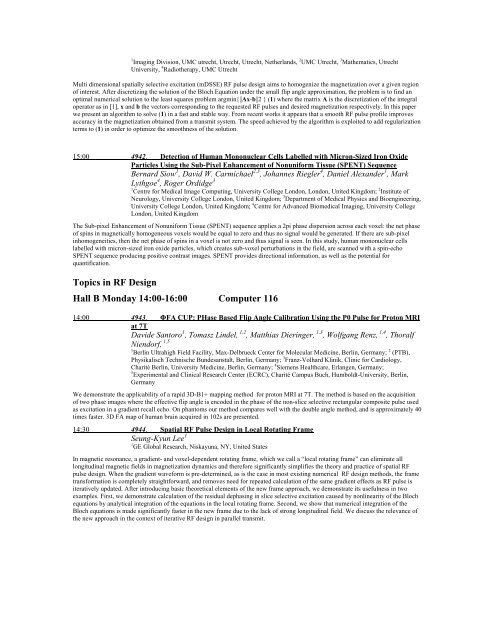ELECTRONIC POSTER - ismrm
ELECTRONIC POSTER - ismrm
ELECTRONIC POSTER - ismrm
Create successful ePaper yourself
Turn your PDF publications into a flip-book with our unique Google optimized e-Paper software.
1 Imaging Division, UMC utrecht, Utrecht, Utrecht, Netherlands, 2 UMC Utrecht, 3 Mathematics, Utrecht<br />
University, 4 Radiotherapy, UMC Utrecht<br />
Multi dimensional spatially selective excitation (mDSSE) RF pulse design aims to homogenize the magnetization over a given region<br />
of interest. After discretizing the solution of the Bloch Equation under the small flip angle approximation, the problem is to find an<br />
optimal numerical solution to the least squares problem argmin{||Ax-b||2 } (1) where the matrix A is the discretization of the integral<br />
operator as in [1], x and b the vectors corresponding to the requested RF pulses and desired magnetization respectively. In this paper<br />
we present an algorithm to solve (1) in a fast and stable way. From recent works it appears that a smooth RF pulse profile improves<br />
accuracy in the magnetization obtained from a transmit system. The speed achieved by the algorithm is exploited to add regularization<br />
terms to (1) in order to optimize the smoothness of the solution.<br />
15:00 4942. Detection of Human Mononuclear Cells Labelled with Micron-Sized Iron Oxide<br />
Particles Using the Sub-Pixel Enhancement of Nonuniform Tissue (SPENT) Sequence<br />
Bernard Siow 1 , David W. Carmichael 2,3 , Johannes Riegler 4 , Daniel Alexander 1 , Mark<br />
Lythgoe 4 , Roger Ordidge 3<br />
1 Centre for Medical Image Computing, University College London, London, United Kingdom; 2 Institute of<br />
Neurology, University College London, United Kingdom; 3 Department of Medical Physics and Bioengineering,<br />
University College London, United Kingdom; 4 Centre for Advanced Biomedical Imaging, University College<br />
London, United Kingdom<br />
The Sub-pixel Enhancement of Nonuniform Tissue (SPENT) sequence applies a 2pi phase dispersion across each voxel: the net phase<br />
of spins in magnetically homogeneous voxels would be equal to zero and thus no signal would be generated. If there are sub-pixel<br />
inhomogeneities, then the net phase of spins in a voxel is not zero and thus signal is seen. In this study, human mononuclear cells<br />
labelled with micron-sized iron oxide particles, which creates sub-voxel perturbations in the field, are scanned with a spin-echo<br />
SPENT sequence producing positive contrast images. SPENT provides directional information, as well as the potential for<br />
quantification.<br />
Topics in RF Design<br />
Hall B Monday 14:00-16:00 Computer 116<br />
14:00 4943. ΦFA CUP: PHase Based Flip Angle Calibration Using the P0 Pulse for Proton MRI<br />
at 7T<br />
Davide Santoro 1 , Tomasz Lindel, 1,2 , Matthias Dieringer, 1,3 , Wolfgang Renz, 1,4 , Thoralf<br />
Niendorf, 1,5<br />
1 Berlin Ultrahigh Field Facility, Max-Delbrueck Center for Molecular Medicine, Berlin, Germany; 2 (PTB),<br />
Physikalisch Technische Bundesanstalt, Berlin, Germany; 3 Franz-Volhard Klinik, Clinic for Cardiology,<br />
Charité Berlin, University Medicine, Berlin, Germany; 4 Siemens Healthcare, Erlangen, Germany;<br />
5 Experimental and Clinical Research Center (ECRC), Charité Campus Buch, Humboldt-University, Berlin,<br />
Germany<br />
We demonstrate the applicability of a rapid 3D-B1+ mapping method for proton MRI at 7T. The method is based on the acquisition<br />
of two phase images where the effective flip angle is encoded in the phase of the non-slice selective rectangular composite pulse used<br />
as excitation in a gradient recall echo. On phantoms our method compares well with the double angle method, and is approximately 40<br />
times faster. 3D FA map of human brain acquired in 102s are presented.<br />
14:30 4944. Spatial RF Pulse Design in Local Rotating Frame<br />
Seung-Kyun Lee 1<br />
1 GE Global Research, Niskayuna, NY, United States<br />
In magnetic resonance, a gradient- and voxel-dependent rotating frame, which we call a “local rotating frame” can eliminate all<br />
longitudinal magnetic fields in magnetization dynamics and therefore significantly simplifies the theory and practice of spatial RF<br />
pulse design. When the gradient waveform is pre-determined, as is the case in most existing numerical RF design methods, the frame<br />
transformation is completely straightforward, and removes need for repeated calculation of the same gradient effects as RF pulse is<br />
iteratively updated. After introducing basic theoretical elements of the new frame approach, we demonstrate its usefulness in two<br />
examples. First, we demonstrate calculation of the residual dephasing in slice selective excitation caused by nonlinearity of the Bloch<br />
equations by analytical integration of the equations in the local rotating frame. Second, we show that numerical integration of the<br />
Bloch equations is made significantly faster in the new frame due to the lack of strong longitudinal field. We discuss the relevance of<br />
the new approach in the context of iterative RF design in parallel transmit.
















